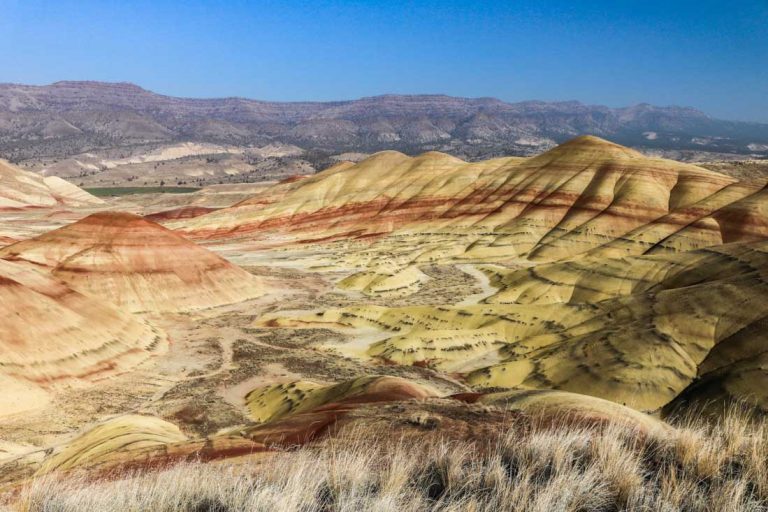15 Scenic Spring Hikes in Yellowstone National Park
Spring may be the shortest season in Yellowstone National Park, but it positively bursts with activity. During the months of April and May, the park reawakens—very much in the literal sense of the word.
Snow starts melting, trees begin budding, bears emerge from hibernation, and bison and elk give birth to calves.
Spring in Yellowstone is a time of birth and growth, of both tranquility and activity, of uncrowded outdoor adventures.
This is a time of year with fewer visitors, allowing you to really immerse yourself in the spectacular Yellowstone landscapes in relative peace and quiet, surrounded by pristine scenery and lots of wildlife.
Below, I’ve compiled a fantastic list of the best spring hikes in Yellowstone National Park, based on my own time spent in the park throughout May. And while some (popular) trails and areas are or remain closed in spring, there are still many amazing hikes to enjoy in Yellowstone National Park in springtime.
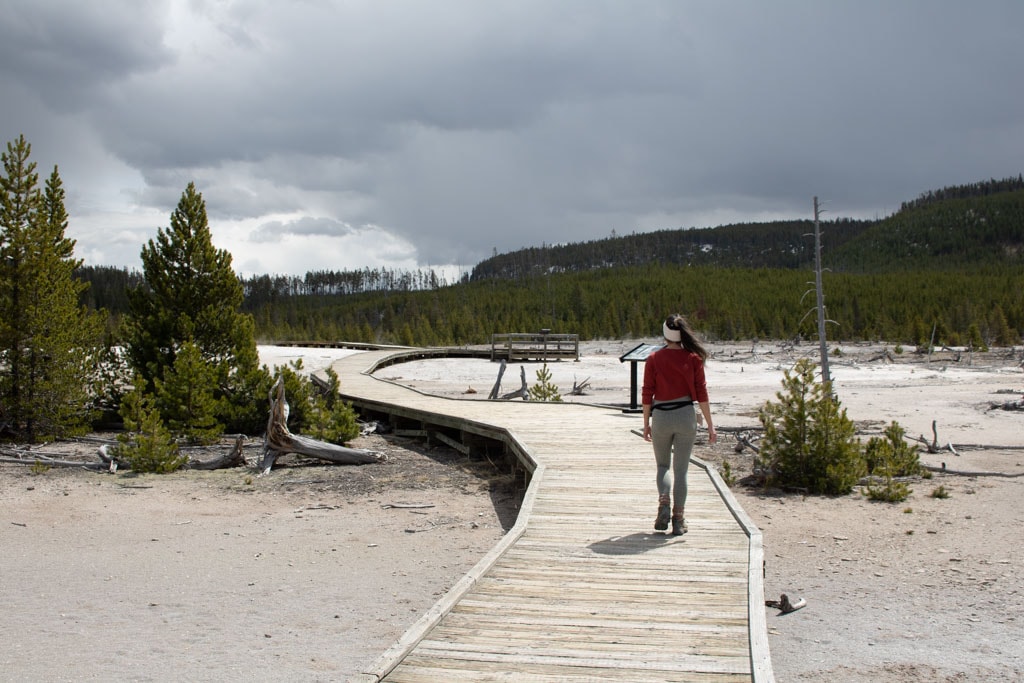
This blog post about the best spring hikes in Yellowstone National Park contains affiliate links. You can read more about our Terms of Use / Disclosure here.
Hiking in Yellowstone National Park in Spring
Hiking Yellowstone in spring can be an exceptionally rewarding experience, yet it could also come with some challenges. After all, the weather is notoriously unpredictable in spring in Yellowstone, while wildlife is abundant and very active.
Spring Weather in Yellowstone National Park
Some days may actually feel like spring and even summer, with sunny skies and comfortable temperatures, while others could bring a surprise snowstorm.
This is just to say that you should come prepared for pretty much all types of weather. Bring everything from winter jackets and rain clothes to a light sweater for warmer days.
Generally speaking, however, the weather does tend to improve as the season progresses. April is the colder, wetter, and cloudier of the spring months.
Most roads also remain closed to vehicles until the end of April, which is certainly something to take into account. (You can check the park’s road status here.)
May, on the other hand, while also having the occasional rainstorm or even snowfall, is typically warmer and drier. By mid-May, most of the roads in Yellowstone National Park will be open, too.
Therefore, I recommend that you plan your spring hiking trip in Yellowstone National Park in mid- to late-May.
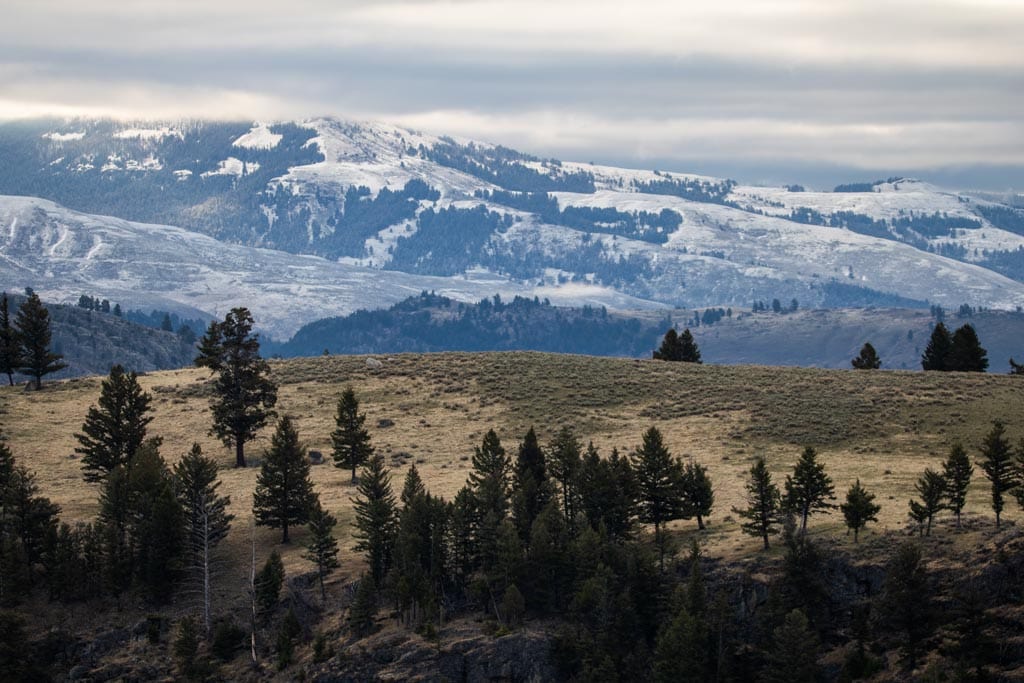
I’ve spent a week exploring Yellowstone National Park in the middle of May myself, and experienced several different types of weather, from sudden snowfall to surprisingly sunny days, from chilly mornings to patio-weather-like evenings.
My advice would be: visit Yellowstone National Park in spring with an open mind, flexible itinerary, and plan B or even C. If you can, try to visit the park in the second half of May.
If you spend enough time in the park—I do recommend a full week—there should at least be a few days that allow you to do some of the spring hikes in Yellowstone below.
Wildlife in Yellowstone National Park in Spring
One of the main reasons to go hiking in Yellowstone in spring is to see the park’s famous wildlife in its natural habitat. By May, most of the Yellowstone animals will be out of hibernation, have given birth to calves, and/or searching for food.
This, of course, requires you to be vigilant, prepared, and informed when going on spring hikes in Yellowstone.
Countless calves are born in Yellowstone in spring. All large mammals give birth in spring in the park. First are the Yellowstone bison who give birth to their so-called “red dogs.” Next up are elk, followed by moose and pronghorn.

All those newborn calves are easy prey for the iconic predators of Yellowstone. After a long and harsh winter, wolves and bears are drawn to the abundance of calves in the park, while they also feed on winterkill (carcasses of animals that didn’t make it through the winter).
Male bears are usually the first to emerge from hibernation, often as early as the beginning of March. Sows with cubs leave their dens a bit later, usually in late-April and early-May.
So, come mid-May, all of the bears in Yellowstone will be out and about, wandering the valleys and lower slopes in search of sustenance.
Both grizzly bear and black bear sightings are very common through the spring season in Yellowstone. Even encounters aren’t unusual, although serious incidents remain very rare.
To prevent negative human-bear interactions, Yellowstone National Park implements a number of bear management closures throughout the park in spring.

Spring Bear Management Areas in Yellowstone
The spring bear managements areas in Yellowstone National Park are locations with large numbers of bison and elk carcasses and, as such, lots of bear activity.
Activities are restricted in these areas, including complete area closures, individual trail closures, day-use only restrictions, or a four-person-minimum group size requirement.
Some of the places in Yellowstone that are popular in summer are inaccessible in spring due to the high density of bears. This includes the Hayden Valley, Pelican Valley, Blacktail Plateau Drive, and Mount Washburn, among other areas.
You can learn more about bear management in Yellowstone here on the park’s website.
Wildlife Safety When Hiking Yellowstone in Spring
From bison, elk, and moose to grizzlies and black bears, the wildlife in Yellowstone National Park is both a top attraction and a potential danger.
Seeing these beautiful animals in the wild is unforgettable—and one of the reasons millions of people visit Yellowstone each year—but you do need to be prepared and know what to do when you encounter them.
Therefore, I’d like to refer to my wildlife safety guides to learn how to act during animal encounters.
Carry Bear Spray and Know How to Use It
Carrying bear spray is an absolute must when enjoying spring hikes in Yellowstone National Park. Keep it easily accessible, preferably on a holster on your hip, and know how to use it correctly.
I explain in detail how to use bear spray in this comprehensive guide.
You can buy bear spray online here.
More About Yellowstone National Park
- Park Website
- Travel Guide
- Topographic Map
- Top Places to Visit in Yellowstone National Park
- Where to See Wildlife in Yellowstone National Park
- Beautiful Roadside Waterfalls in Yellowstone
- Best Views in Yellowstone National Park
- The Predictable Geysers of Yellowstone
- Accommodation
15 Best Spring Hikes in Yellowstone National Park
Okay, so now that we’ve discussed the park’s weather and wildlife in spring, let’s talk about the best spring hikes in Yellowstone National Park.
The collection of recommend Yellowstone hikes to do in spring below includes both scenic boardwalks and gravel trails.
Many of these trails are fairly easy, short, and suitable for most visitors. There are, however, also a couple of hikes that are a bit steeper and/or more remote.
While I understand it’s quite difficult to do all of these Yellowstone spring hikes in just one visit, you should be able to do at least a few when spending two to three days in the park (provided that the weather cooperates).
To help you choose, I’ve CAPITALIZED the names of the seven spring hikes in Yellowstone that I think are absolutely essential.
They’re among the very best hikes in the park and you should really try to not skip them. (All the others are amazing too, though, but will require a couple of extra days in the park.)
1. Mammoth Hot Springs Trails

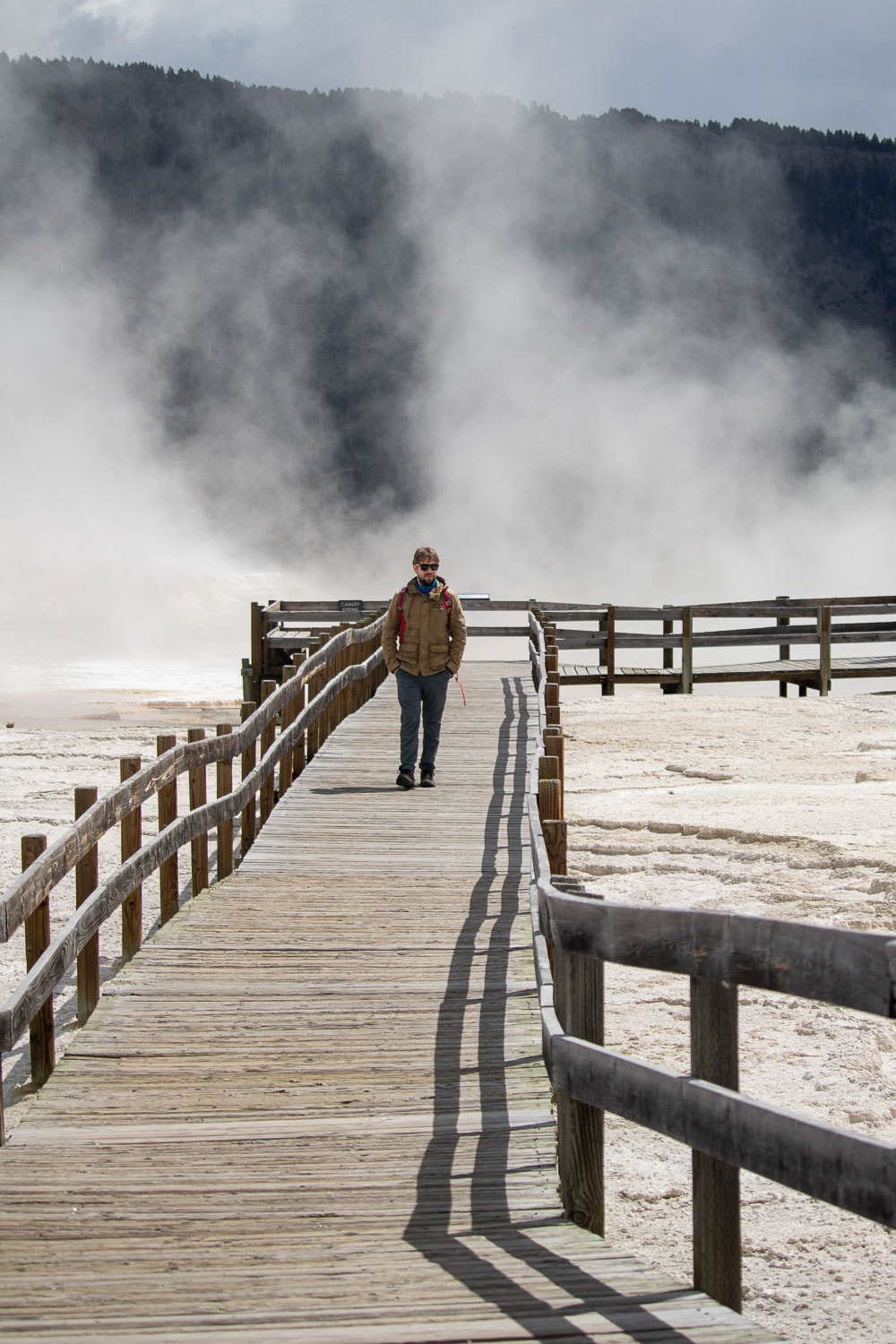
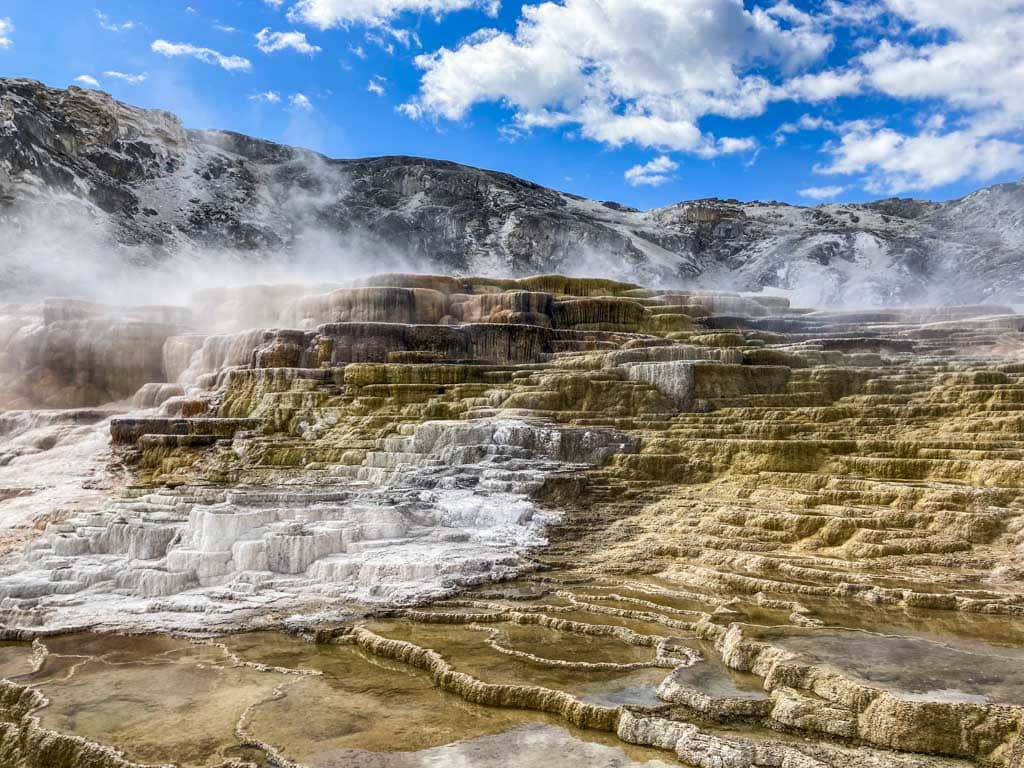
One of the absolute top things to do in Yellowstone National Park is a walk on the Mammoth Hot Springs boardwalks.
One of the park’s many—and among its most extraordinary—hydrothermal areas, Mammoth Hot Springs is a stunning collection of travertine terraces, the result of limestone deposited by hot springs.
In fact, travertine builds up so quickly here, while hot springs dry up and come back to life sometimes overnight, that this is among Yellowstone’s fastest-changing areas. Mammoth Hot Springs literally looks different each year.
So-called thermophiles add a wide range of color to the bright chalk-white travertine, creating a magnificent natural wonder.
A network of boardwalks, trails, and stairways runs through and around the Lower Terraces. Along these walkways, you can see marvelous geothermal features like Palette Spring, Minerva Terrace, and Cleopatra Terrace from up close.
At the top of the Lower Terraces, Canary Spring is a gorgeous white-and-orange hot spring, arguably the most beautiful feature in this particular area.
The Lower Terraces at Mammoth Hot Springs are open year-round and are amazing in spring.
The Upper Terraces, on the other hand, can be explored on the 1-mile Upper Terrace Drive, a one-way drive that’s usually open between mid-May and November.
See many more things to do at and around Mammoth Hot Springs here.
- Distance: Varied
- Duration: 30-90 minutes
- Difficulty: Easy to strenuous
- Trailhead: Mammoth Hot Springs Historic District
- Pets allowed: No
2. Beaver Ponds Loop
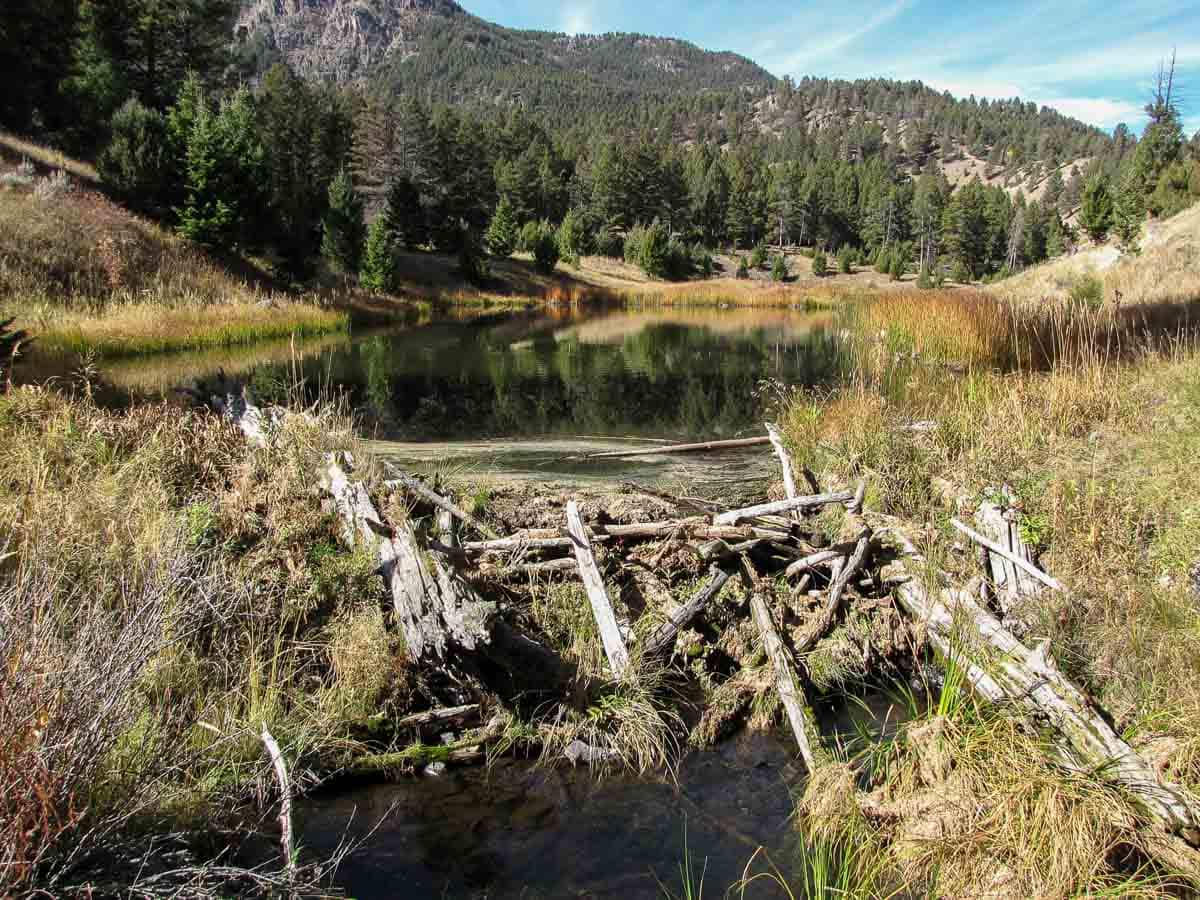
The scenic Beaver Ponds Loop is one of the most popular springs hikes in Yellowstone National Park’s northern portion.
You can start this wonderful 5-mile circuit hike at two locations in Mammoth Hot Springs—near Liberty Cap and behind the Mammoth Hot Springs Hotel.
Highlights along the way are wildflowers, especially in late-spring, as well as excellent wildlife viewing opportunities.
Beavers are sometimes seen in their namesake Beaver Ponds, but even if you don’t see one, you might notice their signs in and around the water. Other animals you might see on the Beaver Ponds Trail are elk, pronghorn, mule deer, moose, and both black bears and grizzly bears.
- Distance: 5 miles total, loop
- Duration: 2-3 hours
- Difficulty: Moderate
- Trailheads: Between Liberty Cap and a stone house, and behind the Mammoth Hot Springs Hotel in Mammoth Hot Springs Historic District
- Pets allowed: No
3. Lava Creek Trail
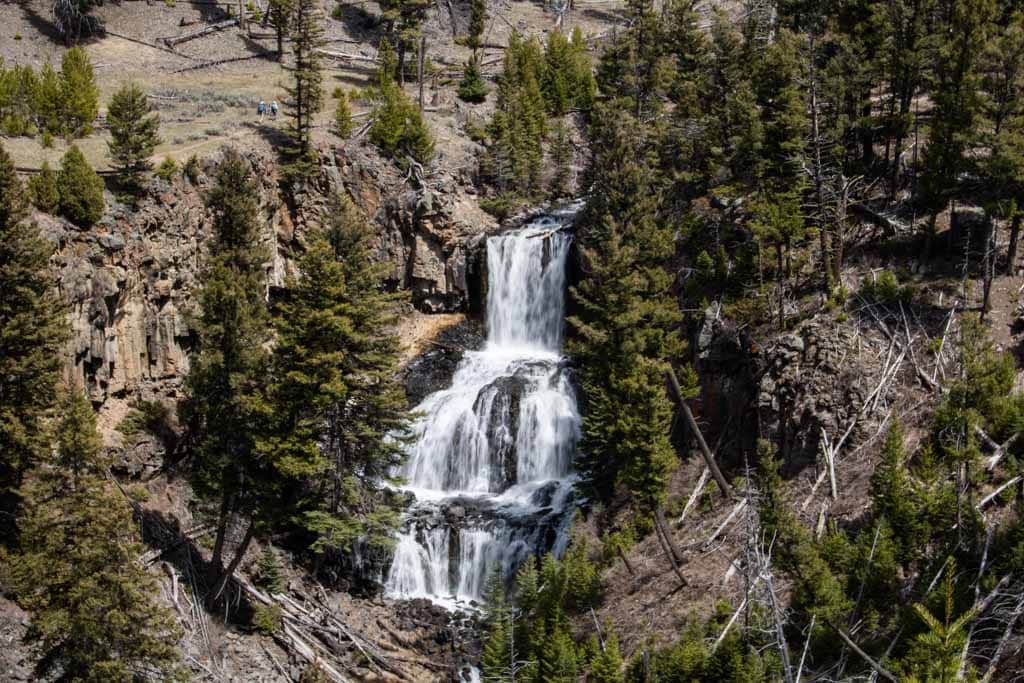
The underrated 4.2-mile Lava Creek Trail can be hiked either as a point-to-point hike with a car shuttle or as a twice-as-long roundtrip hike. Whichever option you choose, it’ll be a memorable spring hike in Yellowstone.
The trail parallels both Lava Creek and the Gardner River. Main points of interest on the way include beautiful Undine Falls and the Lava Creek-Gardner River confluence.
You can also see ancient lava flows, as well as sagebrush slopes and the typical patchy forest scenery of Blacktail Deer Plateau.
Keep your eyes peeled for wildlife, such as grizzlies, elk, deer, pronghorn, and occasionally bison.
- Distance: 4.2 miles one way (8.4 miles roundtrip, out and back)
- Duration: 2-3 hours one way (4-5 hours roundtrip)
- Difficulty: Moderate
- Trailheads: Across the road from the Lava Creek Picnic Area, and across the road from the Mammoth Campground
- Pets allowed: No
4. Wraith Falls Trail

One of the shortest and easiest spring hikes in Yellowstone National Park, the Wraith Falls Trail starts just east of Undine Falls on Blacktail Deer Plateau.
This 1-mile roundtrip hike takes you across sagebrush-covered meadows, interspersed with forest, to the lovely 79-foot Wraith Falls.
It’s a fairly flat trail that’s suitable for families with children, but remember that grizzly bears are present in this area from spring through fall.
- Distance: 1 mile roundtrip, out and back
- Duration: 30-60 minutes
- Difficulty: Easy
- Trailhead: Roadside pullout about 0.5 mile east of the Lava Creek Picnic Area
- Pets allowed: No
5. Blacktail Deer Creek to Yellowstone River Trail
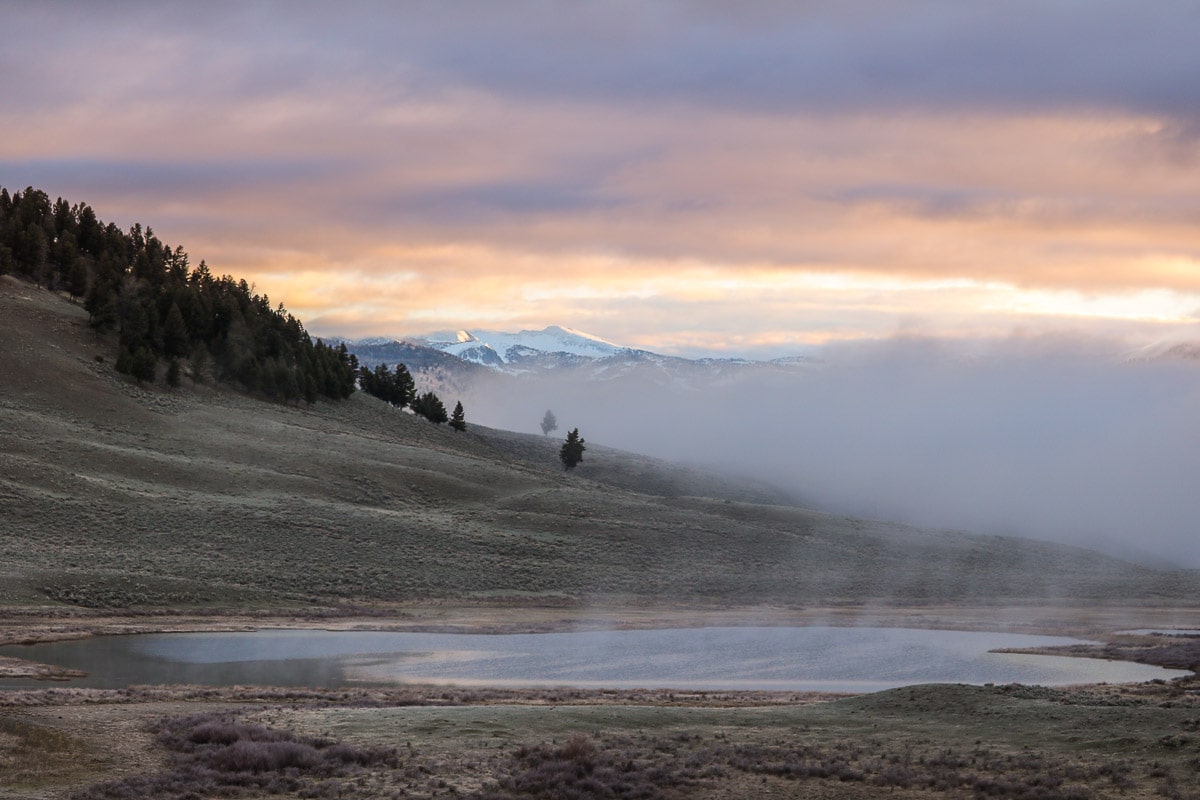
Starting just east of the picturesque Blacktail Pond, this off-the-beaten-path trail in northern Yellowstone is a great hike for solitude, beautiful mountainous scenery, and wildlife.
As its name indicates, the trail follows Blacktail Deer Creek to a suspension bridge over the Yellowstone River, just across the Wyoming-Montana border.
There’s an elevation loss of 1,100 feet from the trailhead to the Yellowstone River, which is 3.7 miles one way. This means, of course, that the way back involves a gradual 1,100-foot climb.
Along the way, you’ll hike over grassy sagebrush-covered hills and through stands of Douglas firs.
Thanks to that open terrain, you can enjoy amazing views of the Blacktail Deer Plateau landscape. Wildlife is often seen in the distance, including elk, pronghorn, deer, gray wolves, and bears.
- Distance: 7.4 miles roundtrip, out and back
- Duration: 4-5 hours
- Difficulty: Strenuous
- Trailhead: Just east of the Blacktail Ponds, about 7 miles east of Mammoth Hot Springs
- Pets allowed: No
6. Yellowstone River Picnic Area Trail
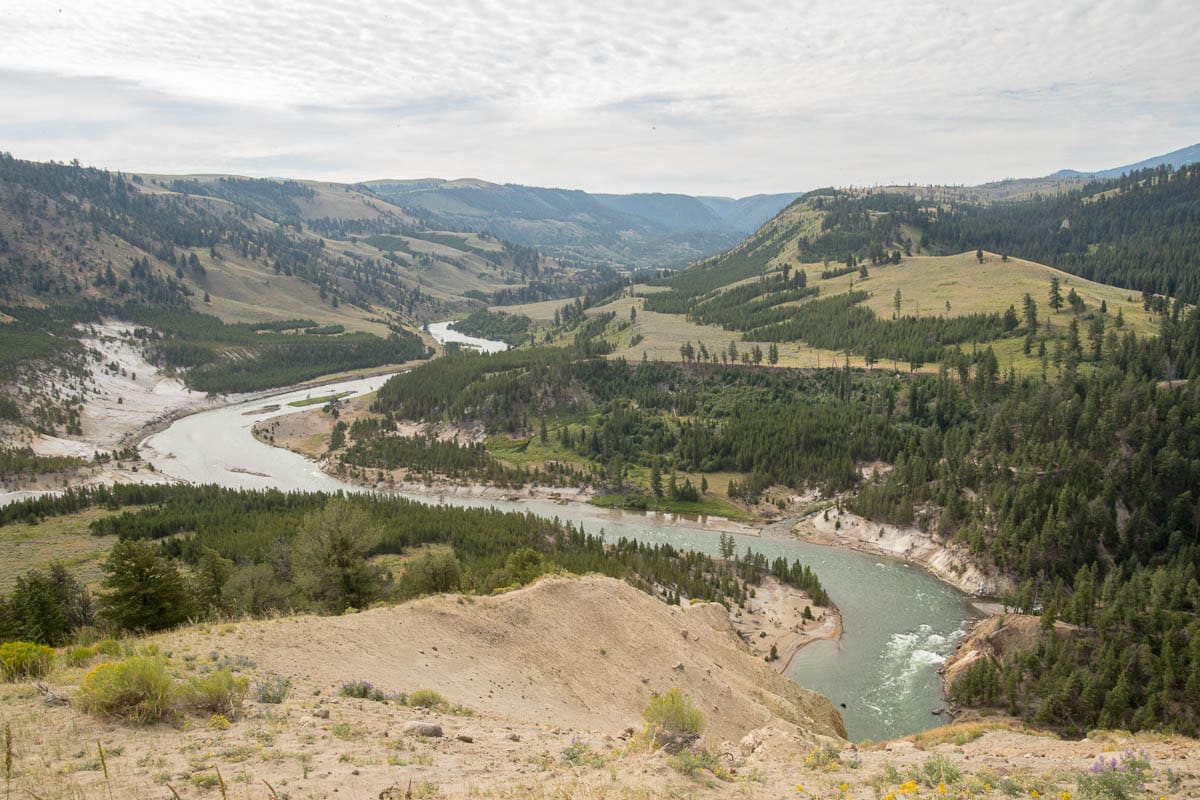
Often overlooked by eager visitors traveling between Tower Junction and the Lamar Valley, the Yellowstone River Picnic Area Trail is one of the best spring hikes in Yellowstone National Park’s Northern Range.
The trail starts at the Yellowstone River Picnic Area, which is incidentally one of my favorite picnic spots in the entire park. It’s a great place to kick back after your hike and cook up a nice outdoor dinner.
Its first section is a rather steep ascent to the east rim of the Narrows of the Yellowstone. Once on the rime, the trail flattens out a bit and follows the cliff edge, ending at the spectacular Yellowstone River Overlook.
At the overlook, you can see the towers of Tower Fall, although the waterfall itself isn’t visible, as well as striking basalt columns, the Overhanging Cliff area, and the historic Bannock Ford.
Additionally, it’s not uncommon to see some wildlife here, too, especially birds of prey like peregrine falcons and osprey. Look for bighorn sheep along the rim.
- Distance: 3.7 miles roundtrip, out and back
- Duration: 2-3 hours
- Difficulty: Moderate with a steep start
- Trailhead: Yellowstone River Picnic Area just east of Tower Junction
- Pets allowed: No
7. Trout Lake Trail

One of the shortest Yellowstone spring hikes on a gravel trail, Trout Lake is a small lake in the heart of the wildlife-rich Lamar Valley.
From the trailhead on the Northeast Entrance Road, you’ll climb about 150 feet through a Douglas fir forest to the lakeshore. The Trout Lake Trail encircles this beautiful little lake, offering excellent views of the surrounding mountains, cliffs, meadows, and forests.
This really is a super-scenic spring hike, which I highly recommend doing if you have an a extra hour to spend in the Lamar Valley.
Do watch out for bear activity on this trail, though. Especially in spring after hibernation, but also in summer and fall, grizzly bears frequent the area.
- Distance: 1.2 miles total, lollipop loop
- Duration: 1 hour
- Difficulty: Easy
- Trailhead: Pullout on the Northeast Entrance Road in Lamar Valley, about 1.5 miles south of the Pebble Creek Campground
- Pets allowed: No
8. Grand Canyon of the Yellowstone North Rim Trail
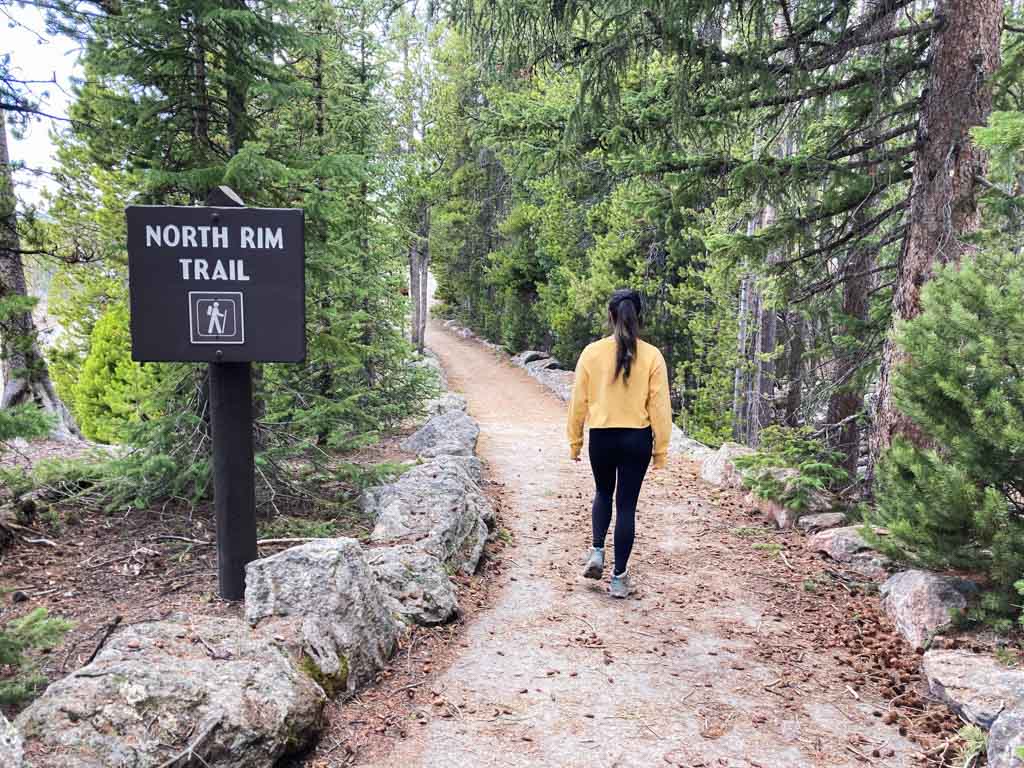


The breathtaking Grand Canyon of the Yellowstone is one of the crown jewels in America’s national parks. It’s a huge highlight of any visit to the park and one of my personal favorite spring hikes in Yellowstone.
You can hike along both rims, but the North Rim Trail is easily the best one. It runs between Chittenden Bridge and Inspiration Point, on the way passing by several other scenic viewpoints like Lookout Point and Grand View.
A popular side trail known as the Brink of the Lower Falls Trail is 100% worth doing, too. Although very steep, it’s only 0.8 miles roundtrip and leads to a viewing platform above the magnificent 308-foot Lower Falls.
You don’t have to hike the entire 3.2 miles of the North Rim Trail to get the full experience, though.
I, myself, opted to split the trail up into two separate shorter hikes: the section of the North Rim Trail between Lookout Point and Inspiration Point, and the Brink of the Lower Falls Trail.
- Distance: 6.4 miles roundtrip, out and back (but shorter options are possible)
- Duration: 3-4 hours (or less depending on your chosen distance)
- Difficulty: Moderate
- Trailheads: Chittenden Bridge and Inspiration Point (or other parking areas along the North Rim Drive)
- Pets allowed: No
9. Mud Volcano Loop
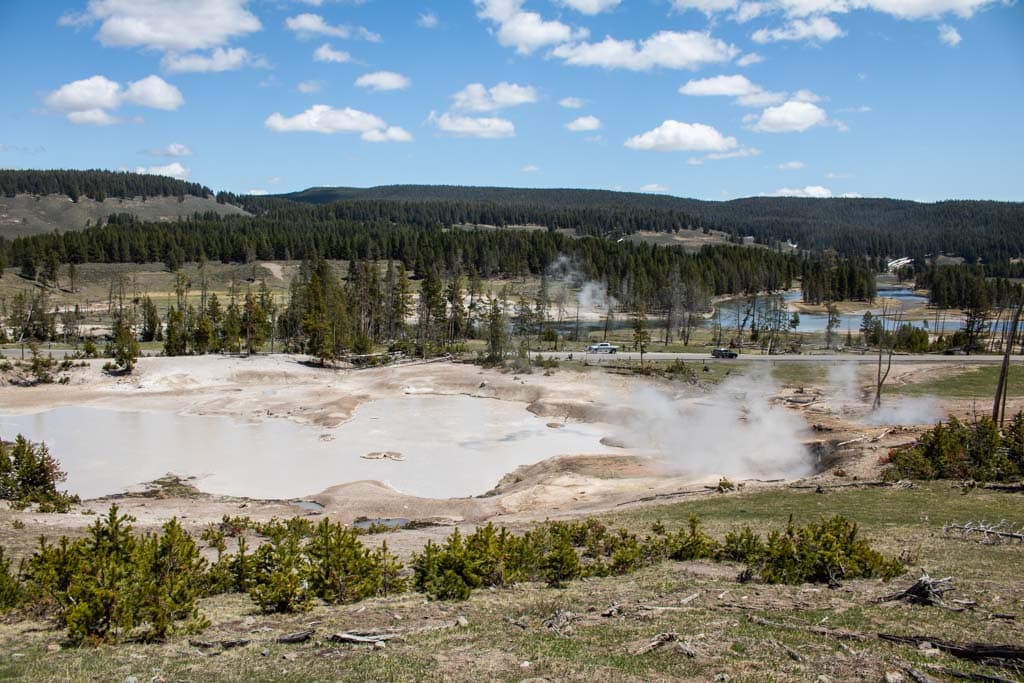
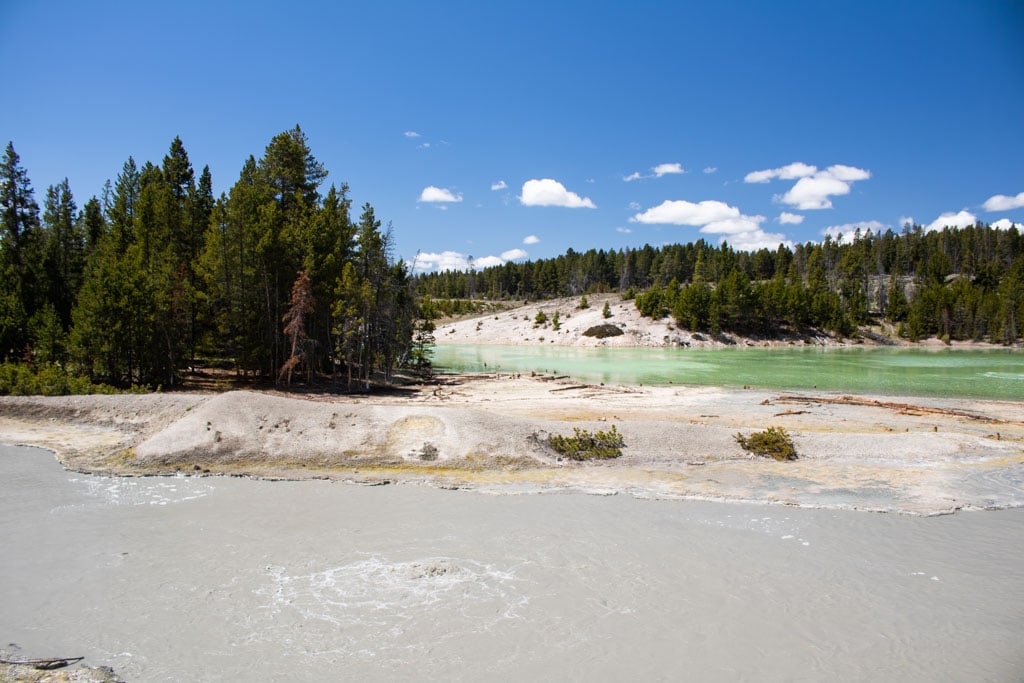

A less-known area in Yellowstone National Park, Mud Volcano offers an up-close view of the park’s hydrothermal activity. This is arguably the best place in Yellowstone to experience a “resurgent dome.”
Resurgent domes “are areas of active ground deformation, where the land moves up and down with the fluctuation of the magna chamber below,” the National Park Service says.
The Mud Volcano is one of those domes, a “breathing hill” within the giant Yellowstone Caldera, located near the biggest sinking and uplifting of the caldera floor. Additionally, this is also at the convergence of many faults, making earthquakes a common occurrence.
You can explore this fascinating area on a beautiful 0.6-mile loop trail, comprised of boardwalks, stairs, and pavement.
Several of Yellowstone’s most acidic hot springs are located at Mud Volcano and the rotten egg-like smell of hydrogen sulfide gas is prevalent throughout the area.
Major highlights along the Mud Volcano Loop, one of the top spring hikes in Yellowstone, include the roaring Dragon’s Mouth Spring, turbulent Churning Caldron, and acid-green Sour Lake.
Just north of the parking lot, you’ll find Sulphur Caldron, one of the park’s most acidic hot springs (pH 1-2).
Also keep an eye out for wildlife here. Mud Volcano is near both Pelican Valley and Hayden Valley, both of which are renowned for their large numbers of wildlife, including bison, elk, mule deer, marmots, wolves, and grizzly bears.
- Distance: 0.6 miles total, loop
- Duration: 30-60 minutes
- Difficulty: Easy
- Trailhead: Mud Volcano parking lot, about 6 miles north of Fishing Bridge
- Pets allowed: No
10. West Thumb Geyser Basin Boardwalk
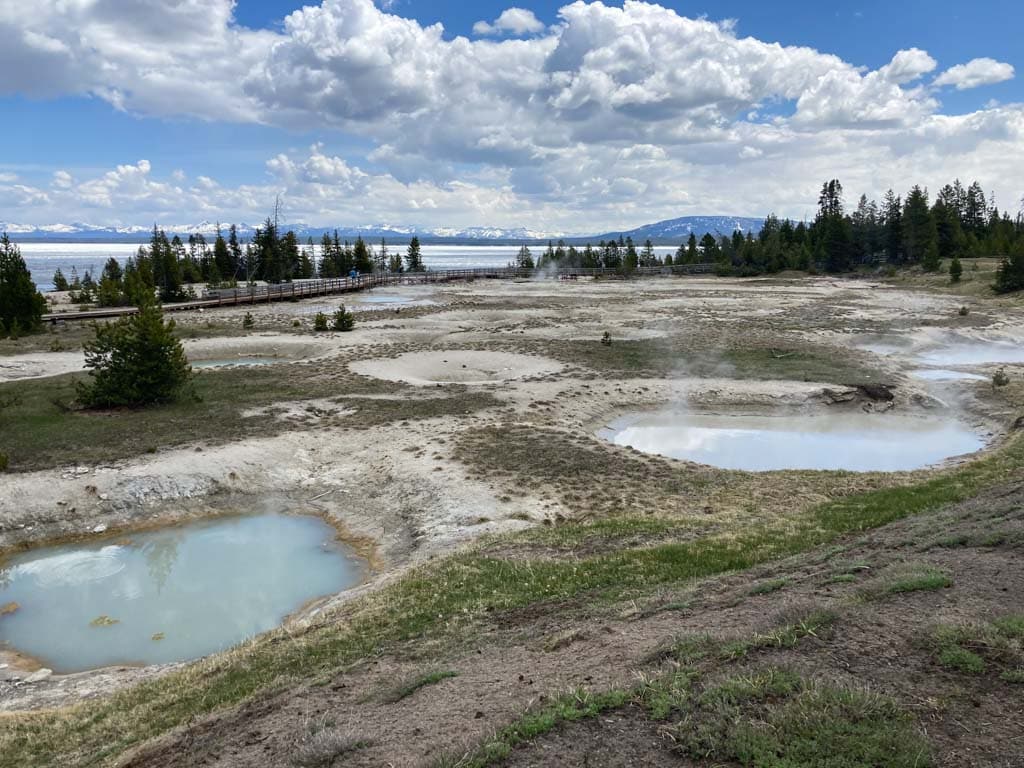

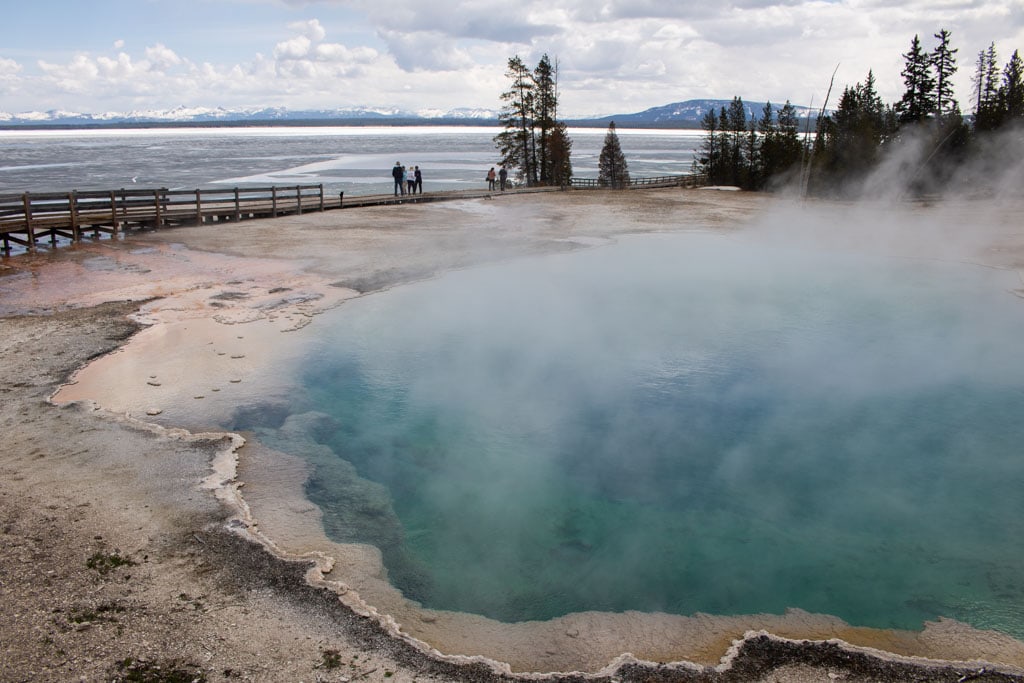
Situated on the far western shore of Yellowstone Lake, the West Thumb Geyser Basin is one of the top things to see in Yellowstone National Park. One of the park’s seven thermal areas, it is in the heart of the gigantic Yellowstone Caldera.
The West Thumb of Yellowstone Lake is actually a caldera within a caldera, formed about 174,000 years ago. That eruption created a depression, which later filled with water and formed a huge bay in the west of the lake.
At the West Thumb Geyser Basin, a figure-8 boardwalk circles through a lakeshore basin dotted with three geysers and almost a dozen mud pots.
Fishing Cone is one of the top attractions at Yellowstone Lake, a geyser where locals and visitors alike used to cook freshly caught fish.
Other highlights at West Thumb include Black Pool and Abyss Pool, one of the deepest hot springs in Yellowstone National Park.
When exploring the West Thumb Geyser Basin, keep an eye out for elk and moose, the occasional grizzly, as well as pelicans and trumpeter swans on the lake.
- Distance: 0.6 miles total, loop
- Duration: 30-60 minutes
- Difficulty: Easy
- Trailhead: West Thumb Geyser Basin parking lot
- Pets allowed: No
11. Upper Geyser Basin to Morning Glory Pool

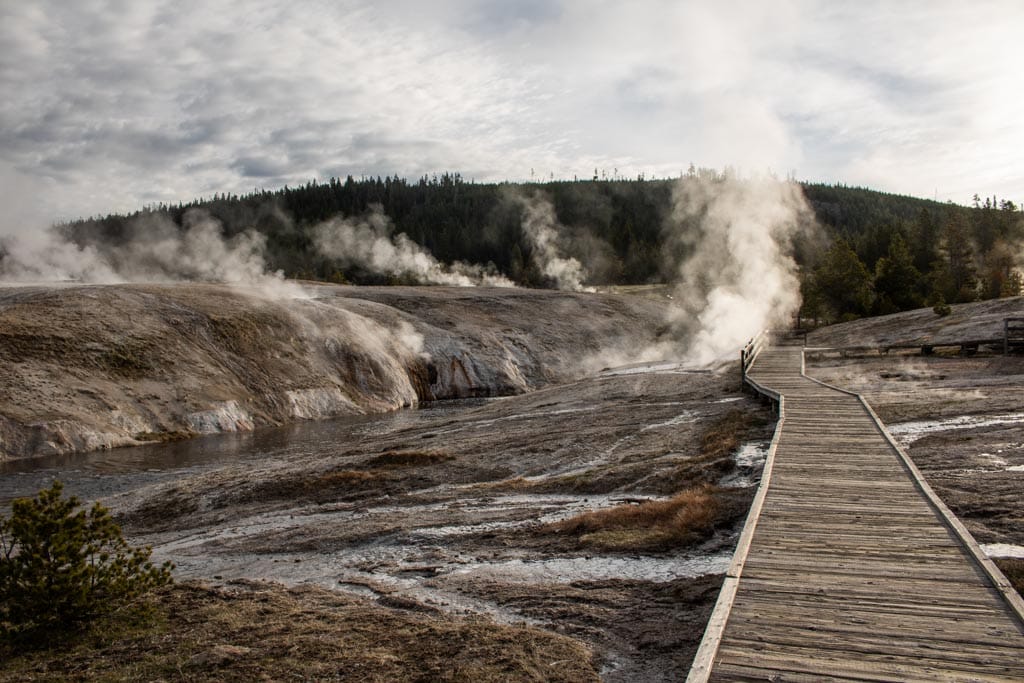
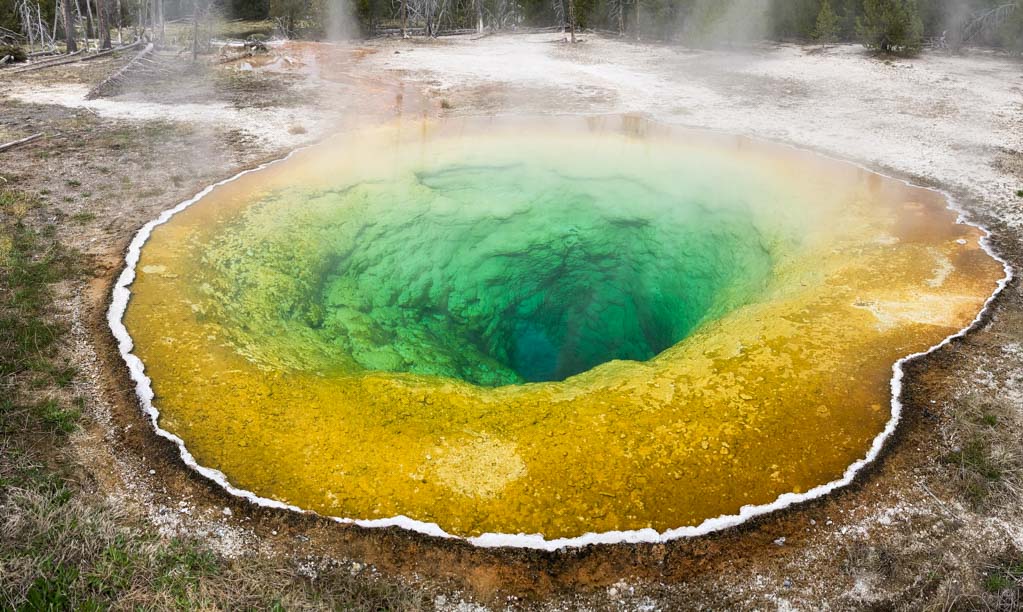
While Old Faithful is the undisputed star of the show, the Upper Geyser Basin is also home to numerous other hydrothermal features, including countless geysers.
In fact, this relatively small area encompasses the largest concentration of geysers in the entire world. Let’s put that in actual numbers, shall we? In this one-square-mile area, there are no fewer than 150 geysers.
Of those 150+ geysers, only five are predicted regularly, though. They are the following:
- Old Faithful Geyser
- Castle Geyser
- Grand Geyser
- Daisy Geyser
- Riverside Geyser
Check the National Park Service website for geyser eruption prediction in the Upper Geyser Basin.
Other geysers that erupt fairly regularly, although cannot reliably be predicted, include the remarkable Grotto Geyser and popular Beehive Geyser.
To watch all major geysers in the Upper Geyser Basin erupt, you’ll need to spend at least two days there. You could, however, see them all on a delightful loop hike, which can be done in just a couple of hours.
The hike I suggest is a circuit that starts at Old Faithful and runs to the mesmerizing Morning Glory Pool before looping back around.
This hike takes you along both geyser-lined banks of the Firehole River, allowing you to see literally dozens of hydrothermal features, including the famous geysers, but also colorful hot springs, mud pots, and fumaroles.
This is without question one of the essential spring hikes in Yellowstone National Park, taking you from the park’s most famous attraction to a kaleidoscopic collection of other hydrothermal features.
It’s a phenomenal hike, which I recommend doing as early in the morning as possible for maximum solitude, tranquility, and enjoyability. (It is very busy here from mid-morning through dinner time.)
- Distance: 3 miles total, loop
- Duration: 1-3 hours (or more when timing your hike around eruption times)
- Difficulty: Easy
- Trailhead: Old Faithful
- Pets allowed: No
12. Observation Point Trail

For a panoramic view of Old Faithful, take a hike on the Observation Point Trail.
This hike begins on the Old Faithful boardwalk, which you’ll follow in a counterclockwise direction until you get to the sign for Geyser Hill.
Turn right and continue down the pathway. The start of the Observation Point Trail is just beyond the bridge across the Firehole River.
You’ll then climb a number of switchbacks through the forest to an overlook that offers a sweeping view of much of the Upper Geyser Basin. It’s 0.8 miles one way. Retrace your steps down the trail.
- Distance: 1.6 miles roundtrip, out and back
- Duration: 1-2 hours
- Difficulty: Moderate
- Trailhead: North of the bridge across the Firehole River between Old Faithful and Geyser Hill
- Pets allowed: No
13. Midway Geyser Basin Boardwalk
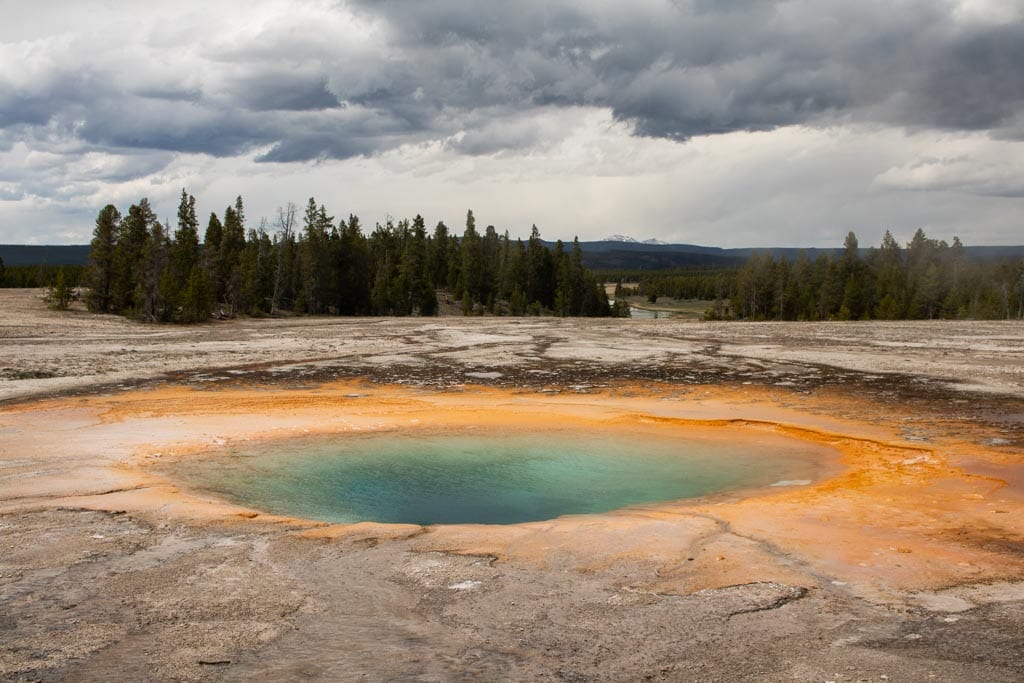
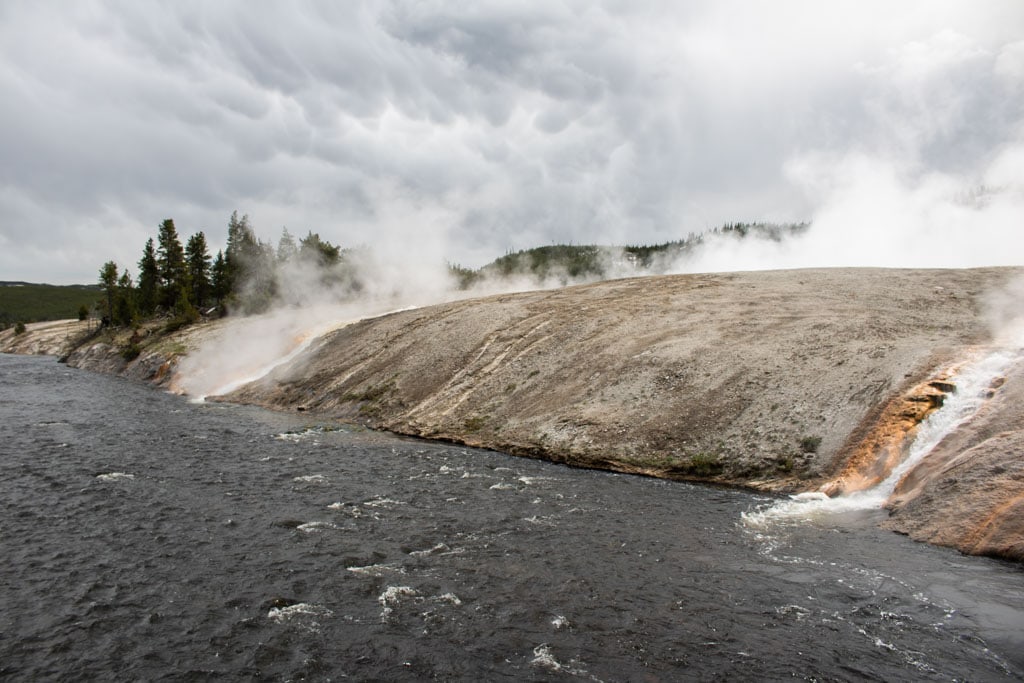
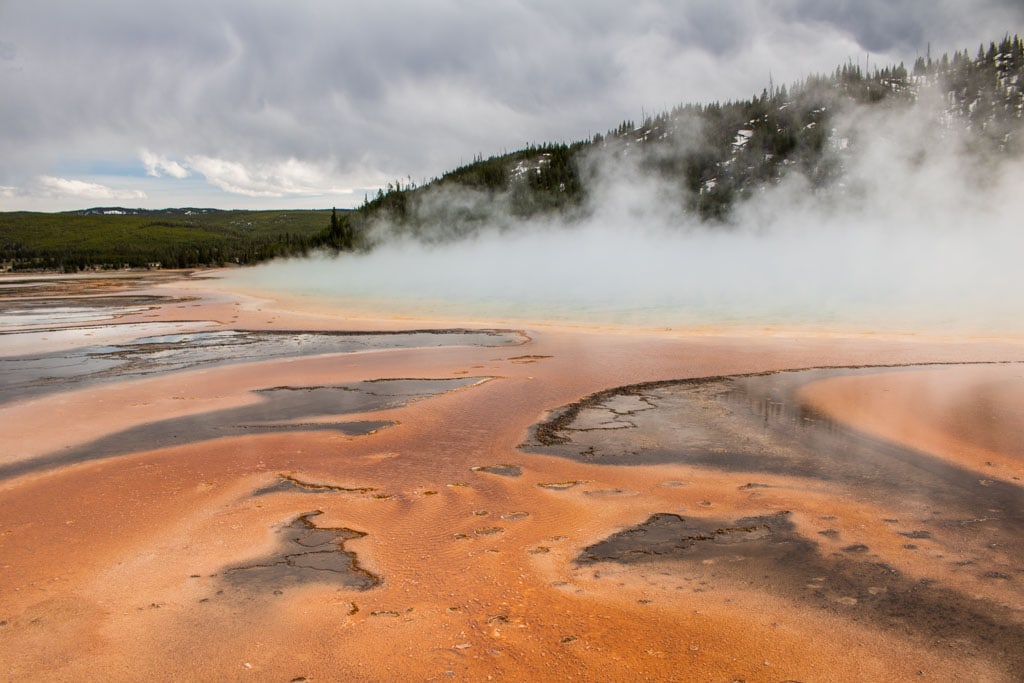
One of the most popular places to visit in Yellowstone National Park is Grand Prismatic Spring at Midway Geyser Basin.
The third-largest hot spring on Earth, this giant pool of steaming water has a diameter of 370 feet and is 121 feet deep. It’s an absolute natural wonder and among the top attractions in the park.
A boardwalk runs past the Grand Prismatic Spring, offering close-up views of its vibrant colors, which radiate out in concentric circles from its stunningly blue depths.
Each color corresponds with a certain water temperature, which supports different bacterial life, the so-called thermophiles.
The Midway Geyser Basin boardwalk also loops along the crater of Excelsior Geyser. Although this is a dormant geyser, it’s still an exceptionally active hot spring, discharging over 4,000 gallons of hot water into the Firehole River every single minute.
The lollipop-shaped loop on the boardwalk is only about 0.8 miles long, one of the easiest spring hikes in Yellowstone National Park.
- Distance: 0.8 miles total, lollipop loop
- Duration: 30-60 minutes
- Difficulty: Easy
- Trailhead: Midway Geyser Basin parking lot
- Pets allowed: No
14. Artists Paintpots Trail

It may be a pretty small area, especially compared with some of the more famous attractions in the park, but Artists Paintpots is nonetheless an interesting and lovely place for a spring hike in Yellowstone.
Located about 4 miles south of Norris, it is home to a group of colorful hot springs and lively mud pots.
These pools of hot mud bubble and burst continuously, often in noisy spurts that can catapult mud 10 feet into the air.
The best views of Artists Paintpots are from the top of the 1-mile lollipop trail, which includes both boardwalks and gravel paths.
- Distance: 1 mile total, lollipop loop
- Duration: 30-60 minutes
- Difficulty: Easy
- Trailhead: Artists Paintpots parking lot, just north of Monument Geyser Basin and south of Norris
- Pets allowed: No
15. Norris Geyser Basin Loops
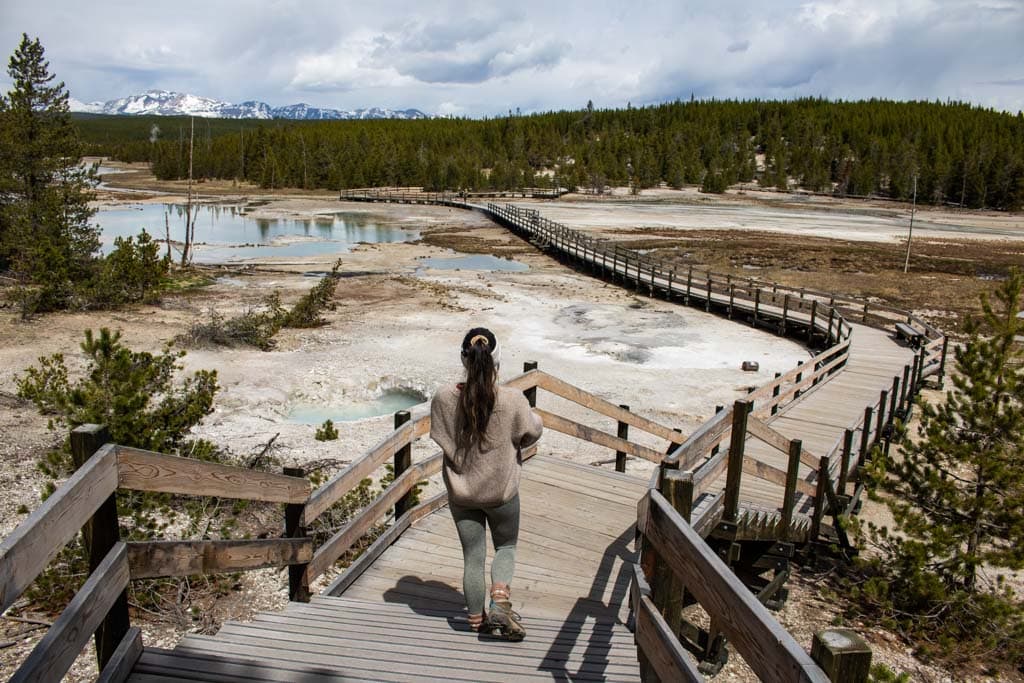
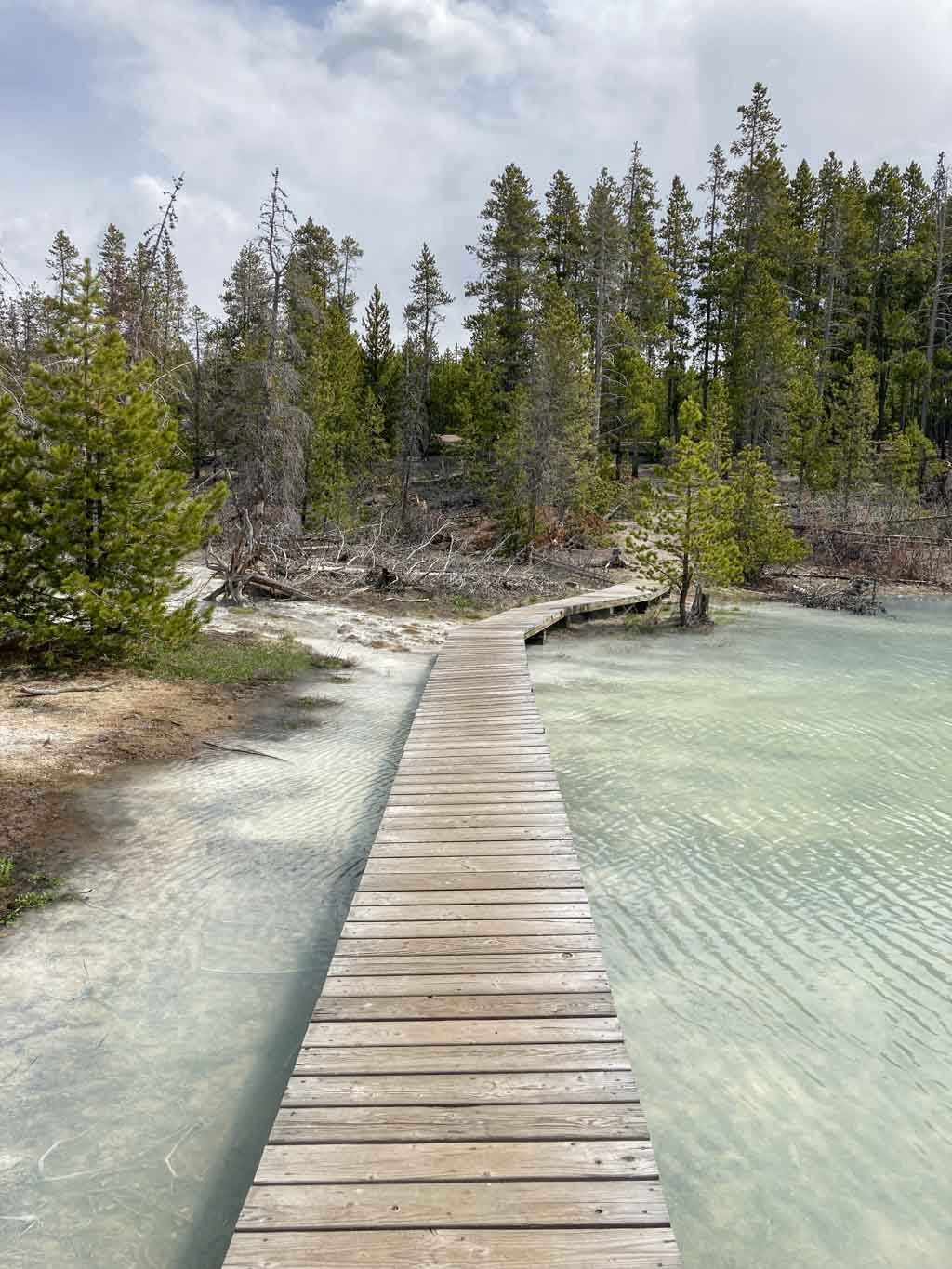

One of the hottest and most acidic thermal areas in Yellowstone National Park, Norris Geyser Basin is extremely volatile and dynamic. This is an active earthquake area, set at the intersection of three major faults.
The result of these conditions is a geyser basin dotted with huge hot springs and massive geysers. Every year, Norris looks a bit different as features appear, go dormant, or come back to life.
Hot springs can suddenly turn into geysers, while geysers may calm down and become muddy pools. At Norris, it seems like everything is possible.
This is one of my favorite places to visit in Yellowstone Park in spring. You can really feel the hydrothermal energy here.
The Norris Geyser Basin is split up into two separate basins. A 0.75-mile boardwalk loops around Porcelain Basin, the smallest of the two, taking in features like Crackling Lake, Hurricane Vent,and Whirligig Geyser.
You can explore the larger Back Basin on a 1.5-mile boardwalk loop. This is where you’ll find Norris Geyser Basin’s most famous and arguably beautiful features.
The vibrant blues of Cistern Spring and Emerald Spring are amazing to look at, while Echinus Geyser is the largest known acidic geyser on the planet.
The star attraction at Back Basin, however, is Steamboat Geyser. Eruptions may be days, months, or even years apart, but when it does go off, this is the tallest geyser in the world, spouting hot water over 300 feet into the sky.
Seeing Steamboat Geyser erupt is truly one of the most memorable experiences you can have in Yellowstone National Park—but you do have to be very lucky to be there at the right time.
- Distance: 0.75 miles (Porcelain Basin) and 1.5 miles (Back Basin), both trails are loops
- Duration: 1-2 hours
- Difficulty: Easy
- Trailhead: Norris Geyser Basin parking lot
- Pets allowed: No
Where to Stay in Yellowstone National Park in Spring
The busy spring season in Yellowstone doesn’t really start until late-April. By the end of May, it’s in full swing, with all roads open to vehicle traffic and most services in operation.
If you’re looking for places to stay in Yellowstone National Park for your spring trip, you’ll have several options to choose from, especially if you wait until mid-May.
Below are the projected opening dates of all Yellowstone National Park lodges, cabins, and campgrounds for the 2025 season, listed from earliest to latest.
Click on their names for rates, availability, and to book a room, cabin, or campsite.
2025 Spring Opening Dates for Yellowstone National Park Lodges
- Mammoth Hot Springs Hotel and Cabins: April 25
- Old Faithful Snow Lodge and Cabins: April 25
- Old Faithful Inn: May 2
- Old Faithful Lodge and Cabins: May 9
- Lake Yellowstone Hotel and Cabins: May 9
- Canyon Lodge and Cabins: May 16
- Grant Village: May 30
- Roosevelt Lodge and Cabins: June 6
- Lake Lodge Cabins: June 10
Note that these dates are subject to change depending on weather and other conditions. Visit the Yellowstone National Park Lodges website for current information.
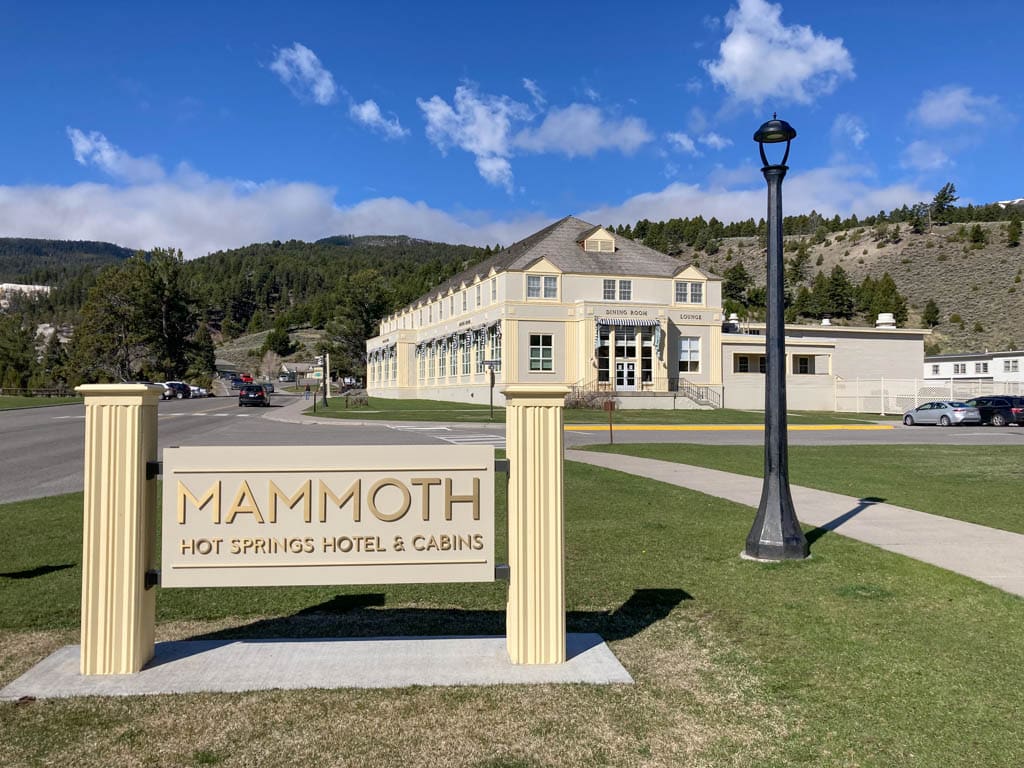
2025 Spring Opening Dates for Yellowstone National Park Campgrounds
- Madison Campground: May 2
- Fishing Bridge RV Park: May 9
- Bridge Bay Campground: May 16
- Tower Fall Campground: May 23
- Canyon Campground: May 30
- Grant Village Campground: June 6
- Lewis Lake Campground: June 15
- Slough Creek Campground: June 15
- Mammoth Campground: Open year-round
- Indian Creek Campground: Closed through 2025
- Pebble Creek Campground: Closed through 2025
For up-to-date information on opening dates, fees, and amenities, visit the campgrounds page on the Yellowstone National Park website.









